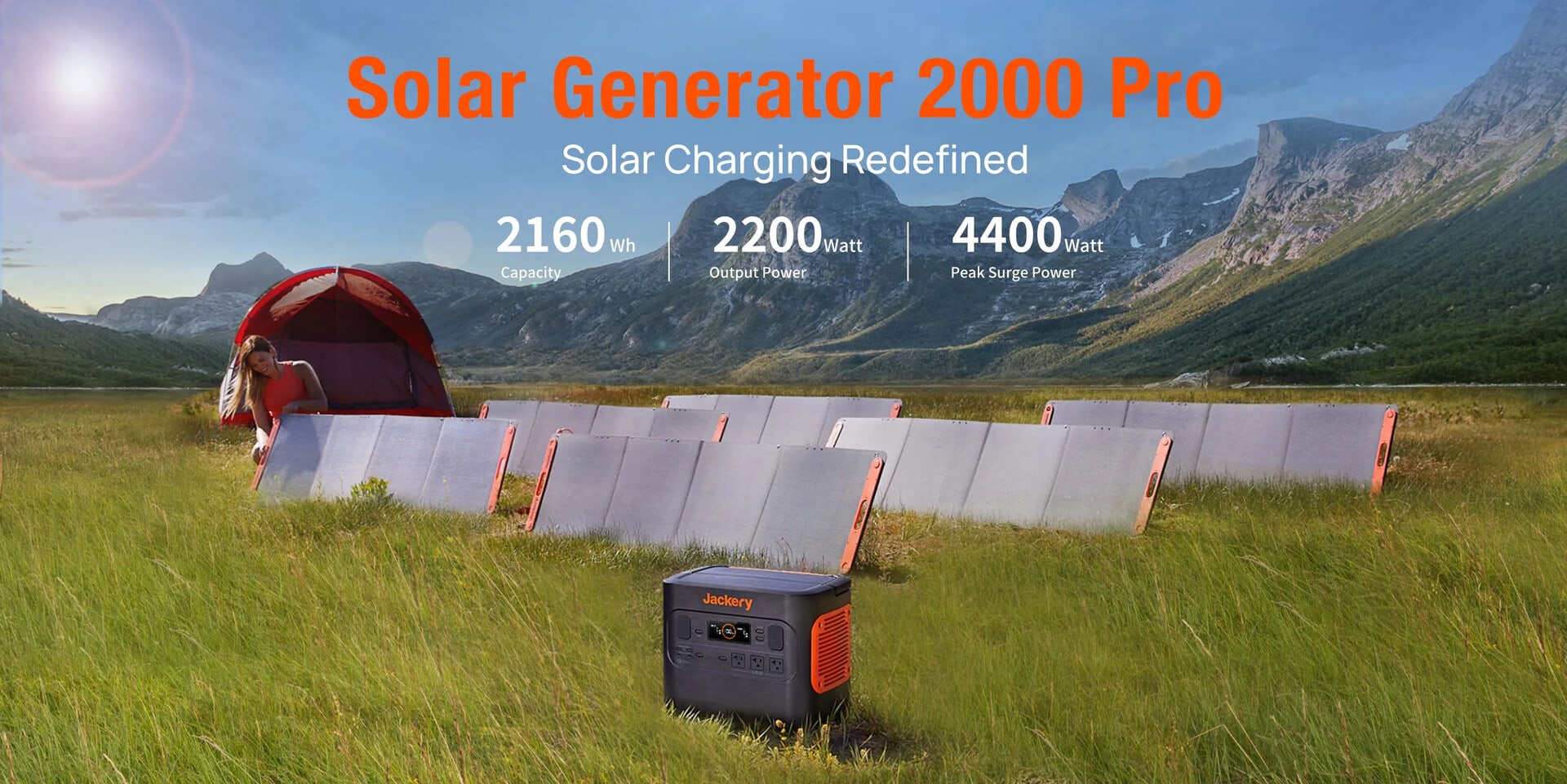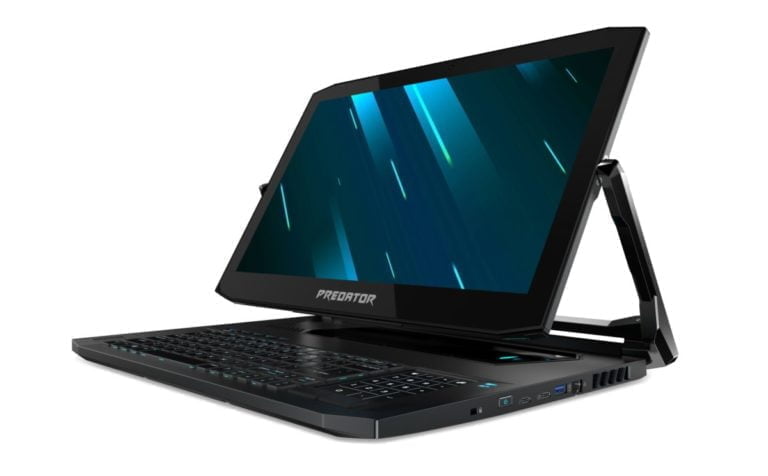Any links to online stores should be assumed to be affiliates. The company or PR agency provides all or most review samples. They have no control over my content, and I provide my honest opinion.
Jackery has finally brought the new Pro range of solar generators to the UK. The Jackery Solar Generator 2000 Pro is the flagship product and consists of the Jackery Explorer 2000 Pro + SolarSaga 200W solar panels.
The model I have been sent is the Explorer 2000 Pro + two SolarSaga 200W solar panels, but you should be able to buy it with a varying number of panels.
Black Friday Offer
The Solar Generator 2000 Pro 400W I have reviewed is on sale until Cyber Monday (28th November).
It is available with £640 discount taking the price down from £3,199 to £2,559.
| Preview | Product | Rating | Price | |
|---|---|---|---|---|

| Jackery Solar Generator 2000 PRO, 2160WH Power Station and... | Buy on Amazon |
Specification
- Battery Information:
- Capacity: 2,160Wh
- Cell Chemistry: Lithium-ion Battery
- Lifecycle: 1000 cycles to 80%+ capacity
- Management System: BMS, Over Voltage Protection, Short Circuit Protection
- Ports:
- AC Output: 230V, 2200W (4400W Surge)
- USB-A Output: Quick Charge 3.0, 18W Max
- USB-C Output: 100W Max, (5V, 9V, 12V, 15V, 20V up to 5A)
- Car Output: 12V, 10A
- DC Input:
- 11V-17.5V, 8A Max, Double to 8A Max
- 17.5V-60V, 12A, Double to 24A/1400W Max
- Recharge Times:
- AC Adapter: 2 Hours
- 12V Car Adaptor: 24 Hours
- 2x SolarSaga 200W Solar Panels: 7.5 Hours
- 4x SolarSaga 200W Solar Panels: 4 Hours
- 6x SolarSaga 200W Solar Panels: 2.5 Hours
- Physical Properties:
- Weight: 43 lbs (19.5 kg)
- Dimensions (LxWxD): 15.1 x 10.5 x 12.1 in (38.4×26.90×30.75cm)
- Operating Usage Temperature: 14-104F (-10-40℃)#
- Warranty: 3 Years
Jackery Pro Differences
The Jackery Solar Generator 2000 Pro is a unique product without a none pro alternative, but it has some important upgrades.
For a like-for-like comparison, I will look at the Jackery Explorer 1000 Pro vs Explorer 1000:
- Different form factor with large carry handle. This is also 1.5kg heavier (15%+)
- Jackery doesn’t state the specific battery chemistry on the Pro models, but the endurance is double with 1000 cycles to 80+% capacity vs 500.
- Warranty has been increased to 3 years vs 2
- Charge speeds have been massively increased. For the 1000 Pro, you can charge at 800W vs 163W (it’s then 1400W with the 2000 Pro!).
- There is support for 4x200W solar panels (800W) vs 2x100W – The 2000 Pro takes this up to 6x200W!
- There are now 2x 100W USB-C ports vs 2 x 36W
At the time of writing, I don’t have UK pricing, but in the US, the Jackery Explorer 1000 Pro is only $100 more than the none Pro. Personally, I think that’s a small price to pay for some significant upgrades.
Features
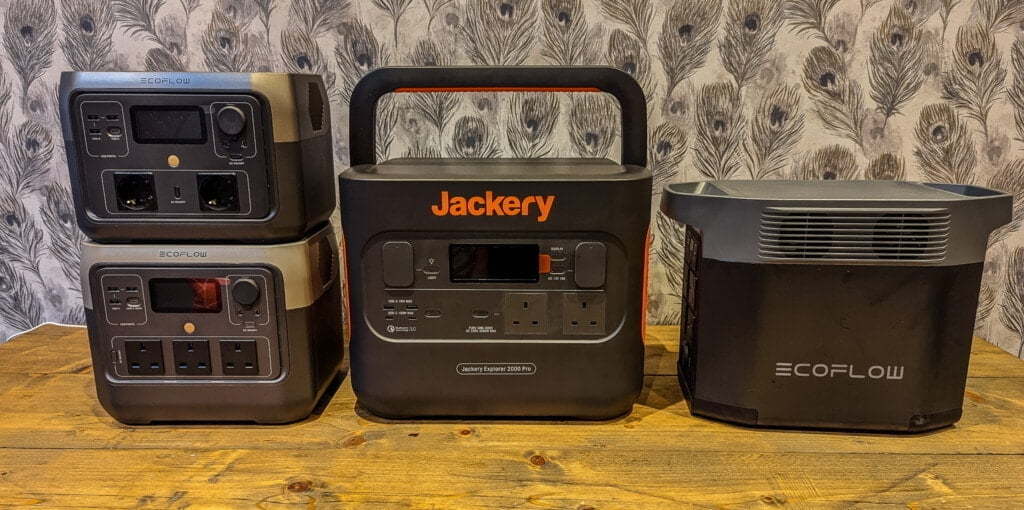
Kids today would describe this as an absolute unit. With this weighing almost 20kg, I can not understate how big and heavy this is. I weight lift quite a bit, so it shouldn’t be that heavy to me, but there is just something different about picking up a 20kg object when you are not doing it for fitness. Thankfully, the massive handle makes it reasonably easy to move around.
The reason why it is so big is the gigantic capacity of 2,160 Wh. Due to working from home, my house uses more electricity than normal and typically chugs along at around 800W. In theory, this could keep my entire 4-bed semi-detached running for over 2.5 hours. Most homes use about 500W, so that’s over 4 hours. Impressive stuff.
It is also worth noting this is only big because of the capacity, When compared to other 2kW power stations, this is reasonably light. It is over 10% lighter than the 22kg EcoFlow DELTA Max (2000) and 30% lighter than the 27.5kg BLUETTI PowerOak AC200P!
Port Configuration
Jackery puts all of its ports on the front of the unit. I prefer this design as it avoids me having to check each end to see which side I need. It also has a flat top, so you can stack them if needed or stack something else on top.
There are only two 3-pin UK plug sockets on this, that’s the same as the Explorer 1000 I previously reviewed, and I would say it is a bit less than I would like. The EcoFlow DELTA 2 has four sockets. It doesn’t matter too much; you can use extension leads. You just need to stay within the power limits.
The USB has been upgraded to 2x 100W USB-C. This is quite important to me as I almost certainly need to power my laptop whenever I am travelling and this avoids me bringing a power delivery plug.
The Jackery comes with a bright orange mains cable. This is more than just a branding exercise; these kettle leads are normally designed for the high-power draw that the Jackery is capable of.
Fan Noise
A big selling point of Jackery is the noise they make. I rarely use mine in my office, so I have never paid too much attention to it. This Jackery, when charging via mains at 680W, does not immediately spin up its fans. When it does, I would say the volume is about the same as my laser printer when it is about to print, and it is louder than my desktop PC, but not annoyingly so.
The same can’t be said for my EcoFlow DELTA 2, which is quite eager to spin its fans. At its full 1200W power draw, it is annoyingly loud, sounding a bit like my server in my box room. Using the app to dial down the charge rate, it is more tolerable, but it is still unpleasant compared to the Jackery, as it has quite a high pitch and is audible over both my PC and music.
Using the Jackery to power the devices in my office, the power draw is only quite low (250W), but the fans remain either quiet or inaudible.
Running High Power Devices
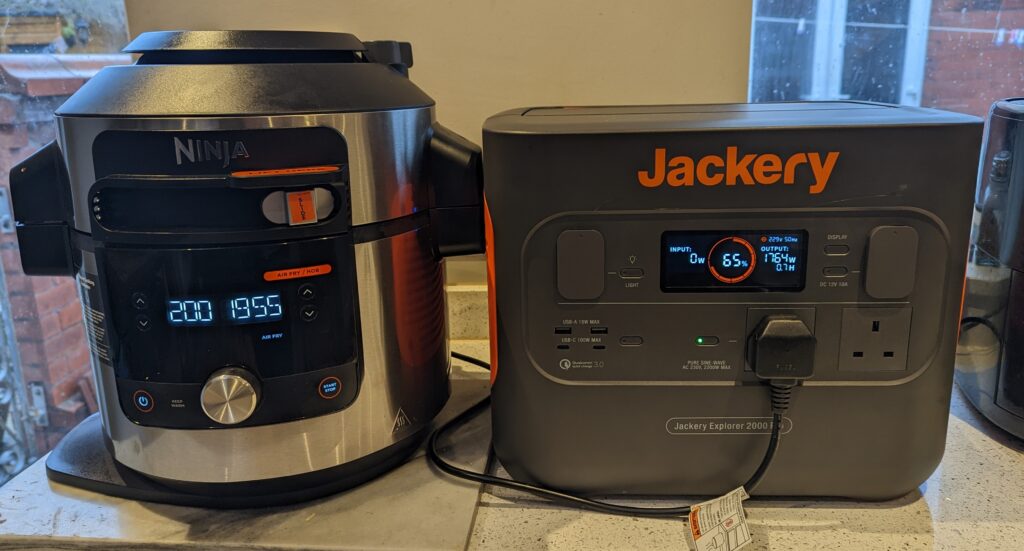
The Jackery Solar Generator 2000 Pro isn’t just a massive battery with a big capacity. It is the only Jackery option that can run high-powered devices. You can find plenty of kettles that run at 2200W, and most air fryers run at under 2000W. It is unlikely I am going to go camping with a full-size kettle or air fryer, but they provided two good example devices that I can run from this gigantic portable power station.
UPS Mode
A lot, but not all power stations, can function as a UPS.
This can, and when connected to an electricity supply, the Explorer 2000 has the ability to charge its battery while delivering power to connected devices at the same time.
Solar Charging
This can handle up to 6 x SolarSaga 200W solar panels for a peak charge rate of 1200W. Which is one of the highest capacities I am aware of. The EcoFlow DELTA Max (2000) goes up to 800W, you’d need the DELTA Pro if you want to exceed 1200W.
It is interesting that Jackery has chosen to use DC ports, which appear to be proprietary. The rear of the Jackery Explorer 2000 Pro has two of these ports, so extending it to six would require you to use two solar panel connectors which have one male and three female solar connectors. In the US, this is $69, and I would expect it to be around £69 in the UK.
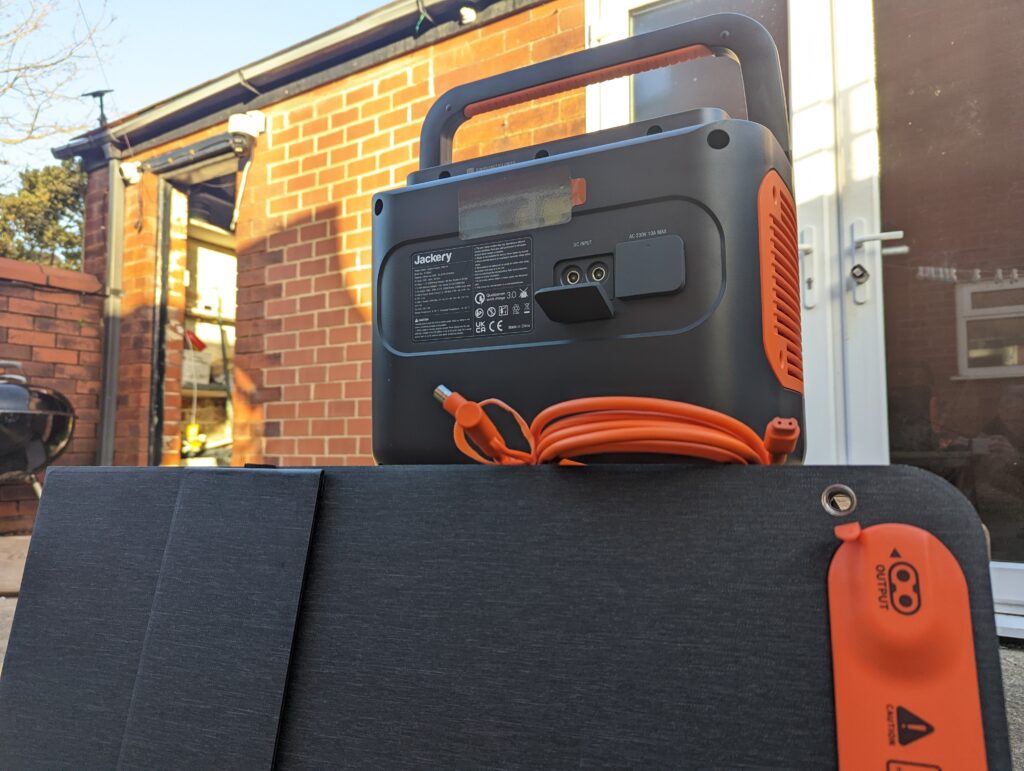
I like the design of the Jackery panels. The 100W panels are extremely easy to open up and set up. The 200W panels are more cumbersome, it is the same basic design, but instead of folded in half, they are folded over four times. Carrying the panels and opening them up is easy enough, but due to their length, it can be a bit fiddly. However, I do find the process easier than the EcoFlow panels; they require you to use the carry case to prop up the panel, whereas Jackery has little kick-out legs.
I reviewed this at the start of November up north in the UK. The forecast has been clouds throughout the review process and, more often than not, rainy. Typical UK.
Therefore, my testing conditions have not been optimate to make the most of the solar charging, but it still works.
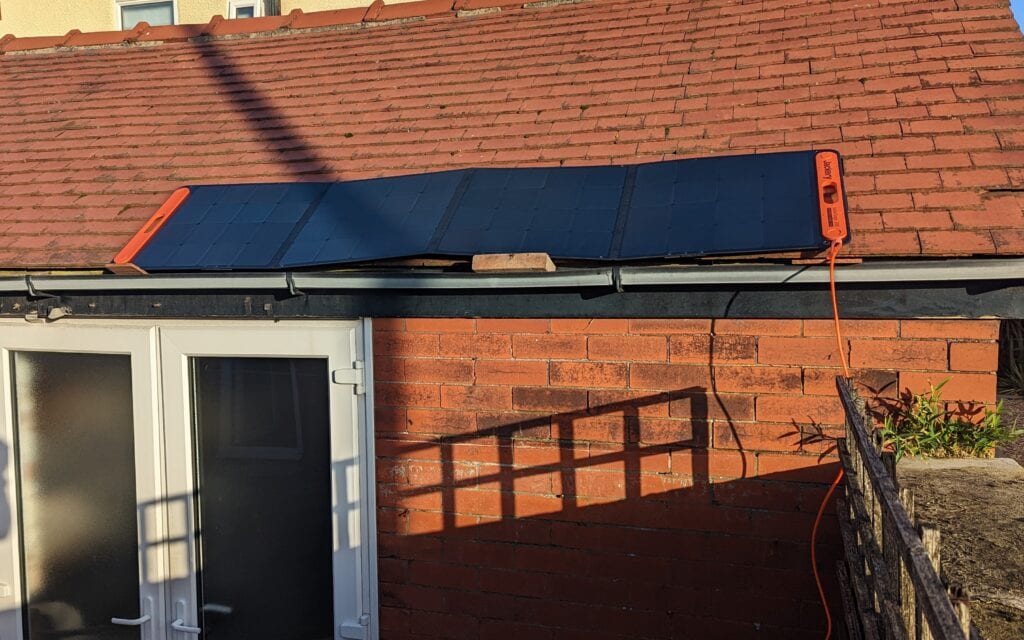
The only hint of sun I got was one morning. I would have been best to set up the panels in my front garden, but I didn’t fancy leaving expensive solar panels unattended in my deprived town. I managed to get one on the roof of my garage, where I was able to achieve a peak of 100W input. Not great, but, not bad considering the inclement weather and the fact it was 10 am in the morning.
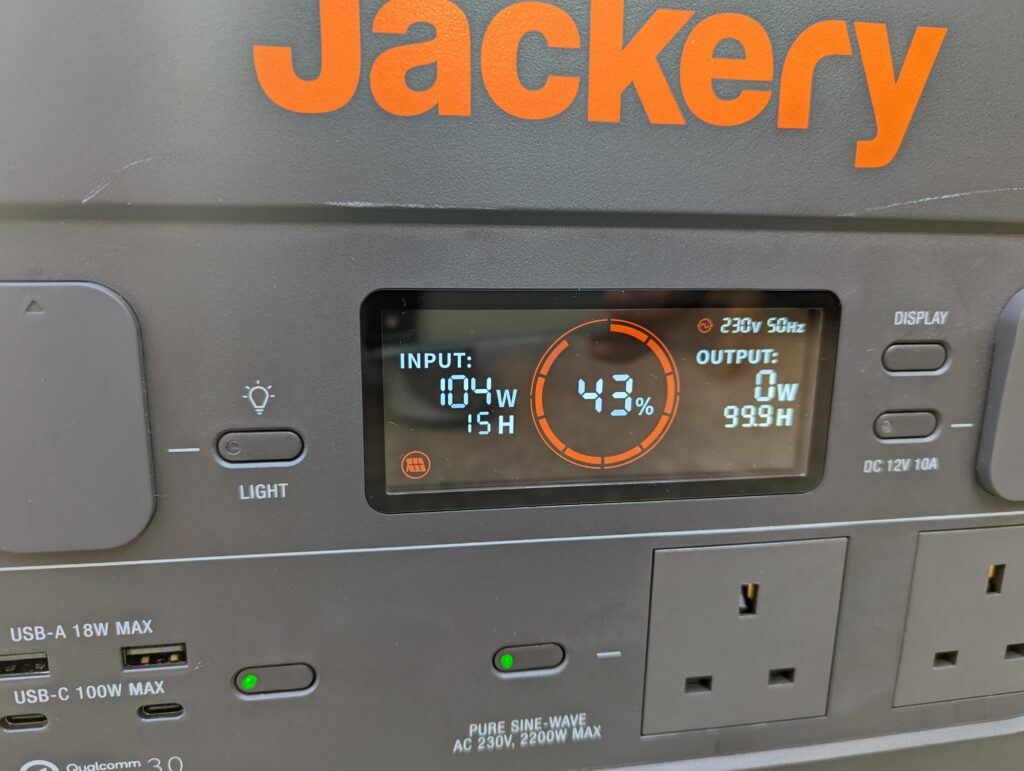
During August, when I reviewed the Jackery Solar Generator 1000, I was able to achieve 80W in the direct sun from the 100W panels. A little research suggests that 170W from the 200W panels is about the norm in good weather.
With two, it should be easy enough to hit over 350W in good weather. That’s comfortably enough to run all the electronics in my office. I’d imagine most off-grid type living conditions, such as canal boats, vans and caravans, would use less than 350W for everything.
Price and Availability
Mine came with two panels, which in the US would set you back $3299 and in the UK £3199.
That’s actually a bit better than I had expected. Looking at the EcoFlow launches recently, they don’t even have £/$ parity, the pound value is quite a bit higher than the USD.
Pricing in the UK is:
- Explorer 2000 Pro + 1x SolarSaga 200W: £2599
- Explorer 2000 Pro + 2x SolarSaga 200W: £3199
- Explorer 2000 Pro + 6x SolarSaga 200W: £5699
The price and configuration for the US models are:
- Explorer 2000 Pro + 1x SolarSaga 200W: $2499
- Explorer 2000 Pro + 2x SolarSaga 200W: $3299
- Explorer 2000 Pro + 4x SolarSaga 200W: $4999
- Explorer 2000 Pro + 6x SolarSaga 200W: $6199
Bluetti is one of the most affordable options if you want a high capacity power station. The AC200P has an RRP of £1948, and the AC200MAX has an RRP of £2099.
EcoFlow has the DELTA Max at £1999, but this uses the NCM battery chemistry and has the same lifespan as the none-pro Jackery units.
Anker is due to launch the Anker 767 PowerHouse, soon. All we know so far is that it will have a capacity of 2048Wh and a peak output of 2400W.
Overall
I think the Pro variant on the Jackery is a much-needed upgrade for their existing excellent portable power stations. I appreciate that it is not always just about the specs, but this brings a lot of the specs close to EcoFlow and Anker.
The Jackery Solar Generator 2000 Pro is obviously the star of the Jackery product line-up. It is massive and incredibly powerful. There are not many 2kWh models on the UK market, and this should easily hold its own against the recently announced Anker 767 PowerHouse.
You will, of course, need to weigh up the pros and cons of a 2kWh power station. They are perfect for caravans or transporting in a large vehicle, but they are heavy and consume a lot of space.
Since a user comment, I have become increasingly aware of fan noise with power stations. Jackery are on the better end of the spectrum, the fans don’t spin up as often as others, and when they do, the sound profile and volume are not as bad as competing brands. This will likely be a massive selling point, depending on your specific requirements.
Overall, the Jackery Solar Generator 2000 Pro is superb and ideal for anyone who needs the endurance of a massive capacity battery or the ability to drive high-powered electronics.
Jackery Solar Generator 2000 Pro Review Rating
Summary
The Jackery Solar Generator 2000 Pro is superb and ideal for anyone who needs the endurance of a massive capacity battery or the ability to drive high-powered electronics.
Overall
90%-
Overall - 90%90%
Pros
- Massive capacity with high power output
- Light compared to competing brands with the same capacity
Cons
- Expensive
I am James, a UK-based tech enthusiast and the Editor and Owner of Mighty Gadget, which I’ve proudly run since 2007. Passionate about all things technology, my expertise spans from computers and networking to mobile, wearables, and smart home devices.
As a fitness fanatic who loves running and cycling, I also have a keen interest in fitness-related technology, and I take every opportunity to cover this niche on my blog. My diverse interests allow me to bring a unique perspective to tech blogging, merging lifestyle, fitness, and the latest tech trends.
In my academic pursuits, I earned a BSc in Information Systems Design from UCLAN, before advancing my learning with a Master’s Degree in Computing. This advanced study also included Cisco CCNA accreditation, further demonstrating my commitment to understanding and staying ahead of the technology curve.
I’m proud to share that Vuelio has consistently ranked Mighty Gadget as one of the top technology blogs in the UK. With my dedication to technology and drive to share my insights, I aim to continue providing my readers with engaging and informative content.
Last update on 2025-07-01 / Affiliate links / Images from Amazon Product Advertising API

